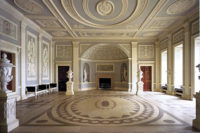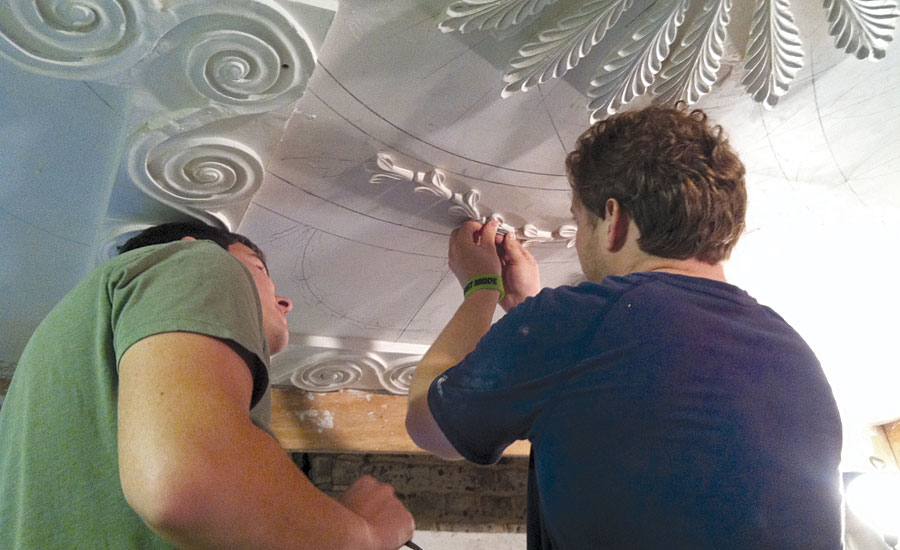History of plastering art
Traditions in the craft of decorative plastering


Gypserie (aka Gebs) is a tradition of carving into gypsum plaster that is very akin to wood carving.

Buon Fresco is painting mineral pigments into lime plaster while it is still fresh.

Clay plastering.






Without question, the art of plastering has always held widespread practical utilitarian value to our built environment. Stuccoes rendered in exterior provide a sacrificial function, protecting vulnerable substrates from erosion and water damage. Plaster applied inside insulates, attenuates sound and provides a sanitary, durable wall surface. Extrusions of profiles in plaster create moldings that add architectural interest, helping to delineate space by means of shade and shadow. However, among the many craft specializations of the decorative and applied arts, plaster is by far one of the most expressive mediums. We’ll take a quick overview of the art of plastering via some of the traditions still practiced in decorative plastering.
Color and Texture
Fortunately, two of the most commonly used minerals to produce plaster, lime and gypsum, are inherently very white and accept color readily. A few clays are also a light grey and can be tinted to produce a broad, if muted range of colors. Other clays are naturally occurring in a variety of earthen colors such as sienna, umber and ochre that most of us love just as they are.
Marmorino, meaning “little marble,” is an Italian tradition of integral colored lime putty plastering inherited from the ancient Romans. Enjoying a 20th century Renaissance in the Veneto, it soon was popularized once again in Italy and now throughout the world.
The French have their own long standing tradition of adding colors and aggregates to plaster. The French plaster is based on gypsum that is naturally more matte than lime. So, instead of marble the French tradition emulates limestone, called Stuc Pierre, meaning “Stone Stucco.” The surface of Stuc Piere is typically shaved with a “Berthelet,” a hand-held plaster razor, and often scored to create joints in imitation of ashlar masonry. Virtually every culture has developed its own artistic flare using color and texture with plaster: Shikkuiin Japan, Tadelaktin Morocco, Enjarrein Mexico to name a few additional examples.
Ornamentation
There are two principal approaches to creating ornamentation in plaster. The first is reductive. Morocco has cultivated master artisans of “gebs,” otherwise known as Gypserie, a wonderful tradition of carving into gypsum plaster that is very akin to wood carving, using similar chisels and gouges.
A more widespread reductive method applied to a variety of different plasters around the world is Sgraffito, carving plaster in very low relief. Sgraffito relies on contrast of color between plaster layers for the effect and is a relatively inexpensive way to add a lot of visual punch.
Of course there are the additive forms of ornamentation for which plaster is famous. The finest ornamented stucco is done by hand, in situ. Lime is the preferred medium although sometimes a quantity of gypsum is added to speed up the work and create higher relief. The most awe inspiring work left by the ancient Romans and emulated in the Renaissance was all painstakingly carried out by hand by armies of sculptors. These must have been very exciting times to be a plasterer. As mold making technologies increased in the 18th century, in situ ornamentation became largely displaced by pre-cast ornamentation in gypsum plaster. Gypsum has a rapid set, just a few minutes, so once time has been invested in a master model, many copies can be made quickly.
Scagliola and Buon Fresco
There are a few really special applications of decorative plastering that could easily take a lifetime to master. One of those is Scagliola, a technique of emulating marble, typically with gypsum plaster. The artistry required is tremendous. Just matching colors as they occur in marble or developing your own color palate is a challenge in itself. As the technique requires cutting, folding and stacking loaves of plaster in various orientations repeatedly, you must continually visualize what is happening inside, how all of those layers are coming together in a natural way, recreating the subtle variegation of color, veining, stratification and fracturing that occur in marble are all separate skills.
Perhaps the highest artistic expression of plaster, one that blurs the line, is Buon Fresco. Painting mineral pigments into lime plaster while it is still fresh takes incredible understanding of materials. The plaster must be prepared in a way so that it maintains a consistent level of dampness for as long as possible. Fresco can be as simple as brushing two or three coats of a mineral wash into a completed wall to give it a soft, cloudy, parchment effect to most elaborate works of fine art and trompe-l’oeil.
What is important to recall about all of these various decorative plastering traditions is that many of them can and are used in combination. Scagliola might be pressed into molds to make ornamental pieces that resemble carved marble. Marmorino or a similar fine lime putty plaster is the grounds for painting Buon Fresco.
The art of plastering really has not changed much in thousands of years. We use the same commonly available materials and techniques we always have. And although to become truly expert at the various arts of decorative plaster requires patience and practice, the truth is they are quite humanistic endeavors, appreciable and accessible to most everyone.
Looking for a reprint of this article?
From high-res PDFs to custom plaques, order your copy today!













